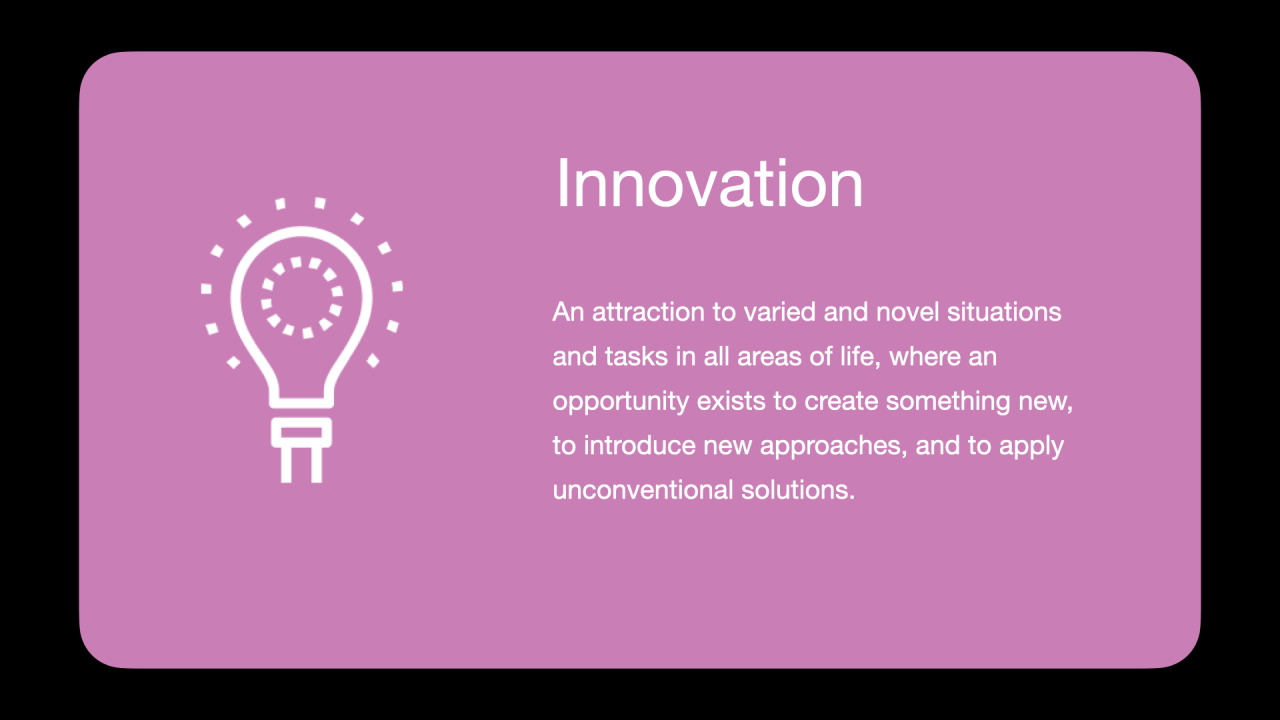
Staying Ahead Innovation Curve
Staying ahead of the curve when it comes to innovation is crucial in today’s rapidly evolving world. This involves understanding the different types of innovation, from incremental tweaks to disruptive breakthroughs. We’ll explore how to identify opportunities, foster a culture of innovation, and strategically plan for success, ultimately equipping you with the knowledge and tools to remain competitive and drive progress.
From defining the essence of innovation to the critical stages of market launch, this comprehensive guide provides a roadmap for businesses and individuals seeking to stay ahead of the curve. We will analyze the key elements of a successful innovation strategy, from identifying emerging trends to implementing and managing innovation projects.
Defining Innovation and Staying Ahead
Staying ahead of the curve in today’s rapidly evolving marketplace requires a deep understanding of innovation. It’s not just about incremental improvements; it’s about identifying and capitalizing on disruptive opportunities that reshape entire industries. This requires a proactive approach, embracing change, and a willingness to challenge the status quo. Innovation, in this context, isn’t just a product or service; it’s a mindset, a culture, and a strategic imperative.Innovation is the process of translating new ideas into valuable products, services, or processes that create significant economic value.
This includes identifying emerging trends, understanding customer needs, and developing solutions that offer a distinct advantage over existing offerings. This approach goes beyond simply meeting current demands; it anticipates future needs and creates solutions that are ahead of the curve.
Defining Innovation in the Context of Staying Ahead
Innovation, in the context of staying ahead, is the creative process of developing and implementing novel solutions that address existing or emerging needs and create a sustainable competitive advantage. This often involves the application of new technologies, methodologies, or business models to achieve a significant improvement in performance or efficiency.
Key Characteristics of Disruptive Innovation
Disruptive innovations often start with a niche market, targeting customers who are underserved by existing products or services. These solutions are initially less sophisticated or appealing to mainstream customers, but they gradually improve and gain traction by offering value propositions that are better suited to the evolving needs of a broader market. Key characteristics include a focus on lower cost, greater accessibility, and a different value proposition that eventually disrupts established market leaders.
For example, the early personal computers were initially less powerful and less user-friendly than mainframes, but they gradually evolved to become the dominant computing platform.
Incremental vs. Radical Innovation
Incremental innovation focuses on refining existing products or services, often through small, iterative improvements. It’s crucial for maintaining a product’s competitiveness and addressing evolving customer preferences. Radical innovation, on the other hand, creates entirely new categories of products, services, or processes that disrupt existing market structures. Identifying when each type of innovation is necessary depends on the specific market conditions and the company’s strategic goals.
For instance, a company might need incremental innovation to maintain market share while pursuing radical innovation to establish new leadership positions.
Companies that Successfully Stayed Ahead
Numerous companies have successfully leveraged innovation to stay ahead of the curve. Apple, for example, revolutionized personal computing and mobile technology with products like the iPod, iPhone, and iPad. Similarly, Netflix transformed the entertainment industry by pioneering a subscription-based streaming service. These examples demonstrate the importance of recognizing and capitalizing on emerging opportunities.
Stages of Innovation
| Stage | Description |
|---|---|
| Idea Generation | Brainstorming, research, and identifying potential opportunities. This stage involves exploring diverse perspectives and analyzing emerging trends. |
| Concept Development | Refining the idea, defining the problem it solves, and outlining the target market. This stage involves detailed planning and market analysis. |
| Prototype Development | Creating a tangible representation of the concept. Testing the viability and potential of the product. |
| Testing and Validation | Gathering feedback and refining the product based on user testing. This is crucial for identifying weaknesses and areas for improvement. |
| Market Launch | Introducing the product to the target market and building awareness. This stage involves strategic marketing and sales efforts to drive adoption. |
Identifying Opportunities for Innovation
Staying ahead of the curve in today’s dynamic market demands a proactive approach to innovation. Simply reacting to existing trends is no longer sufficient. We must anticipate future needs and leverage emerging technologies to create truly disruptive solutions. This requires a keen eye for identifying opportunities, understanding market needs, and analyzing competitor strategies. This exploration will delve into practical methods for uncovering these opportunities.Identifying promising innovations requires a multifaceted approach.
It’s not enough to simply recognize trends; we must understand how they intersect with market needs and potential for disruption. This section provides a structured framework for discovering and evaluating opportunities for innovation.
Emerging Trends and Technologies
Identifying emerging trends and technologies is crucial for anticipating future needs and market shifts. Rapid advancements in artificial intelligence, biotechnology, and renewable energy are reshaping industries. These trends offer significant opportunities for innovation in areas such as personalized medicine, sustainable transportation, and automated manufacturing. Understanding how these technologies interact and overlap is vital to anticipating future opportunities.
Assessing Market Needs and Potential
A thorough understanding of market needs is essential for identifying viable innovation opportunities. This involves more than just identifying existing problems. Proactive market research uncovers latent needs and desires, paving the way for innovative solutions. Key questions in this assessment include: What are the unmet needs in the market? What are the pain points of current solutions?
How can these needs be addressed in a novel and impactful way? Identifying these unmet needs is crucial for creating value.
Market Research Approaches
Different approaches to market research offer unique insights into unmet needs. Quantitative methods, such as surveys and statistical analysis, provide data-driven insights into market trends and preferences. Qualitative methods, such as focus groups and interviews, delve deeper into consumer motivations and pain points, offering a more nuanced understanding of the market. A balanced approach combining both qualitative and quantitative research is most effective for uncovering nuanced insights into consumer behavior and preferences.
Analyzing Competitors
Competitor analysis is essential for identifying opportunities for differentiation. By understanding competitor strategies, strengths, and weaknesses, we can identify gaps in the market that offer potential for innovation. This involves not only examining direct competitors but also considering indirect competitors and disruptive technologies. By analyzing the strengths and weaknesses of competitors, you can discover new approaches to solving existing problems or creating new markets.
This analysis should focus on identifying unmet needs and areas where competitors fall short.
Horizon Scanning for Emerging Technologies
Scanning the horizon for emerging technologies is a proactive way to identify future opportunities. This involves tracking developments in various fields, from materials science to nanotechnology, and understanding their potential applications across different industries. Emerging technologies can disrupt established industries and create new markets. Identifying these technologies early allows us to develop strategies for capitalizing on their potential impact.
Staying ahead of the curve in innovation is crucial, especially in rapidly evolving industries. A great example of this is inkworks printing, expanding its digital printing capabilities to meet modern demands. This forward-thinking approach allows them to provide cutting-edge solutions for customers, which ultimately positions them as a leader in the field. Their commitment to innovation is a key factor in staying ahead of the curve for the long term.
inkworks printing expands its digital printing capabilities
This involves not just recognizing new technologies, but understanding their potential to change market dynamics and create new opportunities.
Fostering an Innovative Culture
Cultivating a culture of innovation isn’t a one-time event but an ongoing process of nurturing creativity, encouraging risk-taking, and fostering collaboration. It’s about creating an environment where employees feel empowered to propose new ideas, experiment with different approaches, and ultimately, drive progress. This dynamic approach requires a shift in mindset, a commitment from leadership, and a carefully constructed framework.A culture of innovation isn’t just about having a few brilliant ideas; it’s about cultivating a mindset where innovation becomes an integral part of the organizational DNA.
This necessitates a consistent emphasis on learning, experimentation, and feedback, fostering a continuous improvement cycle that fuels progress and adaptability.
Building a Framework for Innovation
A robust framework for fostering innovation involves several key components. It’s not simply about implementing a few initiatives; it’s about embedding a culture that prioritizes experimentation, collaboration, and continuous improvement. The framework should encourage a proactive and iterative approach, constantly evolving to meet the needs and challenges of the organization.
Encouraging Risk-Taking and Experimentation
Creating a safe space for experimentation is crucial. Employees must understand that failing is a natural part of the innovation process, and that learning from mistakes is critical for future success.
- Clear Communication of the Value of Failure: Leaders must clearly articulate that failure is not a reflection of worth but a stepping stone to learning and improvement. Acknowledging setbacks and learning from them is a cornerstone of any successful innovation journey.
- Dedicated Experimentation Time: Allocating specific time slots or budgets for experimentation allows employees to explore new ideas without feeling pressured to deliver immediate results. This dedicated time is critical for fostering a culture of experimentation.
- Rewarding Innovation, Not Just Results: Recognize and reward not just the successful outcomes but also the innovative spirit and the courage to take risks. This approach fosters a culture that encourages persistent exploration and creative problem-solving.
Encouraging Collaboration and Knowledge Sharing
Cross-departmental collaboration is vital for innovation. Ideas and perspectives from diverse teams can lead to more robust and impactful solutions.
- Establishing Interdisciplinary Teams: Forming teams with members from various departments fosters a richer exchange of ideas and expertise. This approach can lead to innovative solutions that wouldn’t emerge from siloed departments.
- Utilizing Technology for Knowledge Sharing: Employing platforms for knowledge sharing, such as internal wikis, project management software, and shared document repositories, streamlines the flow of information and facilitates collaboration across departments.
- Encouraging Informal Interactions: Creating opportunities for informal interactions and networking across teams encourages the spontaneous exchange of ideas and fosters a more collaborative atmosphere. These informal interactions can spark serendipitous connections and lead to breakthrough solutions.
Examples of Successful Innovative Cultures, Staying ahead of the curve when it comes to innovation
Several companies have successfully cultivated cultures of innovation. These examples highlight strategies that can be adapted to various organizational contexts.
- 3M: Known for its “15% rule,” which allows employees to dedicate 15% of their time to pursuing their own ideas, 3M has fostered a culture of continuous innovation. This structured approach demonstrates a clear commitment to experimentation and individual initiative.
- Google: Google’s emphasis on experimentation and employee autonomy has created a fertile ground for innovation. Their approach to fostering a culture of risk-taking and encouraging diverse perspectives are key elements in their innovative success.
Implementing Feedback Loops for Continuous Improvement
A crucial aspect of fostering an innovative culture is establishing a system for collecting and acting on feedback.
- Regular Feedback Mechanisms: Implementing regular feedback mechanisms, such as surveys, focus groups, and one-on-one discussions, ensures that employees feel heard and that their insights are valued.
- Actionable Feedback Processes: Establish clear processes for analyzing feedback and taking action to implement changes. A crucial aspect is to demonstrate that feedback is valued and acted upon.
- Continuous Iteration: Embrace a culture of continuous iteration, where feedback is used to refine processes and improve products or services, ensuring the company remains responsive to market changes and customer needs.
Strategic Planning for Innovation
Staying ahead of the curve requires a well-defined strategy for innovation. This isn’t just about random experimentation; it’s about a deliberate, planned approach to identify opportunities, allocate resources effectively, and measure progress. A robust strategic innovation roadmap is crucial for navigating the complexities of the modern marketplace and capitalizing on emerging trends.A strategic approach to innovation is not a one-time event.
It’s an ongoing process of adapting to market changes and emerging technologies, continually refining the roadmap and adjusting resources as needed. This iterative process ensures that innovation efforts remain aligned with the overall business objectives and contribute to sustainable growth.
Creating a Strategic Innovation Roadmap
A well-structured roadmap provides a clear path for innovation initiatives. It should be aligned with the overall business strategy and encompass key aspects of the innovation process. The roadmap should be dynamic and adaptable to evolving market conditions and technological advancements.
- Define clear objectives and measurable goals for innovation initiatives. Examples include increasing market share by 15% in the next three years or developing a new product line that addresses a specific customer need.
- Identify potential innovation opportunities by analyzing market trends, customer feedback, and competitor activities. Consider emerging technologies, disruptive innovations, and potential regulatory changes.
- Develop a timeline for each innovation project, outlining key milestones, deadlines, and resource allocation.
- Assign roles and responsibilities for each stage of the innovation process, ensuring clear accountability and communication channels.
- Establish a mechanism for continuous monitoring and feedback, allowing for adjustments to the roadmap as needed.
Allocating Resources for Innovation Initiatives
Effective resource allocation is vital for successful innovation. It requires a thoughtful approach that balances investment in high-potential projects with careful consideration of feasibility and risk.
Staying ahead of the innovation curve requires constant vigilance, and understanding the evolving regulatory landscape is key. For example, the Corporate Transparency Act, a new piece of legislation, is poised to significantly impact businesses. Learning more about what the Corporate Transparency Act entails and who it affects can help companies adapt strategies to maintain a competitive edge. what is the corporate transparency act and who it will impact Understanding these regulations is crucial for staying ahead of the curve in today’s dynamic business environment.
- Allocate budget and personnel resources based on the potential impact and feasibility of each innovation project. Prioritize projects with a high probability of success and significant market impact.
- Create a dedicated innovation fund or budget line to ensure consistent funding for new initiatives. This dedicated funding stream will facilitate the process of pursuing diverse innovation ideas.
- Consider using a portfolio approach, where different innovation projects are managed according to their individual stages of development.
- Explore partnerships with external organizations or experts to access complementary resources and expertise.
Prioritizing Innovation Projects
Prioritization is critical to ensuring that limited resources are directed towards the most promising innovation projects. A structured approach helps to make objective decisions.
- Evaluate each project based on potential market impact, feasibility of development, and alignment with overall business objectives. Use a scoring system that weights these factors based on their importance.
- Conduct thorough feasibility studies for each project to assess technical viability, market demand, and financial projections.
- Prioritize projects with a strong likelihood of generating significant returns on investment. Projects with a higher likelihood of market penetration and profitability should be prioritized.
Measuring the Success of Innovation Initiatives
Defining and measuring success is essential for evaluating the effectiveness of innovation initiatives. Clear metrics are needed to gauge progress and adapt strategies.
- Establish key performance indicators (KPIs) that measure the success of innovation projects. KPIs should be aligned with the specific objectives of each initiative.
- Track progress against predefined milestones and adjust strategies based on performance data. This allows for flexibility and adaptation.
- Collect feedback from customers, employees, and other stakeholders to gain insights into the effectiveness of innovation projects.
Adapting Strategies to Market Changes
Market conditions and emerging technologies necessitate continuous adaptation. Flexibility is crucial to maintaining a competitive edge.
- Monitor market trends, competitor activities, and emerging technologies to identify potential shifts and adapt the innovation roadmap accordingly.
- Establish a mechanism for regular review and revision of the innovation roadmap. This allows for adjustments based on real-time data.
- Stay informed about technological advancements that may disrupt the market or create new opportunities.
Implementing and Managing Innovation: Staying Ahead Of The Curve When It Comes To Innovation

Bringing innovative ideas to fruition requires a structured approach. Simply conceiving a groundbreaking concept is only the first step; effectively implementing and managing that innovation is crucial for success. This phase demands careful planning, proactive monitoring, and strong leadership. A well-defined system for managing innovation projects ensures that ideas are developed and launched efficiently and effectively.The success of any innovation hinges on the meticulous execution of the plan.
It’s not enough to have a brilliant idea; you need a robust process for turning that idea into a tangible product or service. This includes clear roles and responsibilities, timelines, and resource allocation, as well as a system for tracking progress and addressing roadblocks.
Establishing a System for Managing Innovation Projects
Effective innovation project management necessitates a structured system. This system should include clear roles and responsibilities, well-defined project phases, and measurable milestones. Establishing clear communication channels is vital for keeping all stakeholders informed and aligned. A central repository for project documentation, including proposals, reports, and progress updates, facilitates transparency and collaboration.
Monitoring Progress and Addressing Challenges
Regular progress monitoring is essential to identify potential issues early on. Implementing a system for tracking key performance indicators (KPIs) allows for timely identification of roadblocks and deviations from the planned trajectory. A feedback loop that allows for open communication and problem-solving is critical to addressing challenges effectively. This approach encourages a culture of continuous improvement and adaptation.
The Role of Leadership in Supporting Innovation Initiatives
Leadership plays a pivotal role in championing innovation. Leaders must actively encourage experimentation and risk-taking, fostering a culture where employees feel empowered to propose and pursue new ideas. Providing resources, mentorship, and support to innovators is crucial for their success. Leaders should actively participate in project reviews, provide constructive feedback, and remove roadblocks.
The Importance of Agile Methodologies in Innovation Management
Agile methodologies are particularly well-suited for managing innovation projects. Their iterative approach allows for flexibility and adaptation in response to changing market demands or emerging insights. This iterative process allows for rapid prototyping, testing, and feedback incorporation, leading to faster time-to-market and greater responsiveness. The focus on collaboration and communication inherent in agile methodologies is also vital for fostering innovation.
Communicating Innovation Plans and Updates to Stakeholders
Effective communication is essential for keeping stakeholders informed and engaged. Regular updates, transparent reporting, and clear explanations of progress and challenges are crucial. Visual aids, presentations, and interactive sessions can enhance understanding and build support for the innovation initiatives. Actively soliciting feedback from stakeholders can also improve the outcomes of the projects.
Adapting to Change and Staying Ahead
Staying ahead in the ever-evolving landscape of innovation requires more than just a groundbreaking idea. It demands a robust ability to adapt to market shifts, anticipate disruptions, and leverage change to one’s advantage. This adaptability hinges on a combination of proactive strategies, continuous learning, and a willingness to navigate potential risks associated with new ventures.Market shifts are not just inevitable; they are often disruptive, forcing companies to recalibrate their strategies and operations.
Recognizing these shifts early and responding with agility is critical for sustained success. Proactive measures for anticipating change include meticulous market research, competitor analysis, and a constant awareness of emerging trends.
Staying ahead of the curve in innovation is key, and that means keeping a close eye on emerging trends. The future of sustainable energy, for instance, is looking to alternative materials like graphene and bio-based composites. This innovative approach, as detailed in the future of sustainable energy looks to alternative materials , highlights the importance of exploring these novel options to achieve lasting solutions.
By understanding these developments, we can better position ourselves for the future and continue to stay ahead of the curve.
Strategies for Anticipating and Responding to Market Shifts
Effective anticipation of market shifts involves a multi-faceted approach. Thorough market research, coupled with a keen understanding of customer needs and preferences, provides valuable insights into potential future trends. Staying informed about emerging technologies and industry developments is equally crucial. This involves active participation in industry conferences, networking with experts, and subscribing to relevant publications. Companies that proactively adapt to change, rather than reacting to it, are more likely to succeed.
Examples of Companies That Have Successfully Adapted to Disruptive Change
Numerous companies have demonstrated remarkable adaptability in the face of disruptive change. Netflix, for example, successfully transitioned from a DVD-by-mail service to a streaming giant by recognizing the changing media consumption habits of consumers. Similarly, Apple’s continuous innovation and responsiveness to evolving consumer preferences have ensured its sustained dominance in the tech industry. These examples highlight the importance of recognizing emerging trends and adjusting business strategies accordingly.
Importance of Continuous Learning and Professional Development
Staying ahead of the curve necessitates a commitment to continuous learning and professional development. In today’s dynamic environment, professionals must constantly update their skills and knowledge to remain competitive. This includes attending workshops, taking online courses, and pursuing certifications relevant to their field. Continuous learning allows individuals to acquire new competencies and adapt to evolving technological advancements.
Identifying and Addressing Potential Risks Associated with Innovation
Innovation inherently carries risks. Potential risks include financial losses, reputational damage, and operational disruptions. A comprehensive risk assessment process, involving identifying potential threats, evaluating their likelihood and impact, and developing mitigation strategies, is essential. Thorough planning, contingency strategies, and robust monitoring mechanisms help to manage these risks effectively.
Different Approaches to Managing Change in an Organization
| Approach | Description | Advantages | Disadvantages |
|---|---|---|---|
| Top-Down Approach | Change initiatives are driven by senior management and implemented throughout the organization. | Clear direction and accountability; can be faster to implement. | Potential for resistance from lower levels; may not fully address local needs. |
| Bottom-Up Approach | Change initiatives originate from employees and are gradually implemented throughout the organization. | Employee buy-in and increased ownership; more adaptable to specific needs. | Potential for slower implementation; coordination challenges across different teams. |
| Participatory Approach | Change initiatives are developed through collaboration between management and employees. | Increased employee engagement and commitment; balanced approach considering both perspectives. | Requires more time for consensus-building; potential for disagreements. |
Measuring and Evaluating Innovation Outcomes

Staying ahead of the innovation curve isn’t just about conceiving brilliant ideas; it’s about rigorously evaluating their impact. Measuring innovation outcomes allows businesses to understand what works, what doesn’t, and how to refine strategies for future success. This crucial step ensures that resources are allocated effectively and that innovation initiatives deliver tangible value.Effective measurement goes beyond simply counting new products or patents.
It delves into the broader impact on the company, its customers, and the market. A robust evaluation process allows companies to identify areas of strength and weakness in their innovation pipeline, ultimately optimizing their innovation ecosystem for maximum results.
Metrics for Measuring Innovation Impact
Understanding the impact of innovation requires a multi-faceted approach, encompassing both quantitative and qualitative measures. A range of metrics can illuminate the effectiveness of innovation initiatives. For example, the number of patents filed or new products launched can quantify the output. However, the real value lies in measuring the impact on key business drivers.
- Financial metrics, such as increased revenue, reduced costs, or improved profitability, provide a direct link between innovation and bottom-line results. These measures are critical for assessing the financial return on investment (ROI) of innovation projects.
- Market share gains and customer acquisition rates provide insight into the impact of innovative products or services on the broader market. A rising market share indicates successful innovation in attracting customers.
- Brand perception and customer satisfaction, often measured through surveys and feedback mechanisms, reveal how innovation affects the company’s image and relationships with its clientele. Positive feedback often translates to loyalty and repeat business.
- Employee engagement and retention rates can also reflect the impact of innovation initiatives. Employees who feel empowered and challenged by innovative projects tend to be more engaged and loyal.
Analyzing Data to Assess Effectiveness
Data analysis is essential for understanding the effectiveness of innovation strategies. It allows companies to uncover patterns, identify trends, and make data-driven decisions about future initiatives. This analysis provides insights into the drivers of innovation success.
- Statistical analysis, including correlation and regression, can reveal relationships between innovation activities and key performance indicators (KPIs). For instance, correlations can be observed between marketing campaigns, customer engagement, and sales growth.
- Trend analysis can identify the progression of innovation efforts over time. It allows companies to see whether their strategies are yielding consistent improvement or encountering stagnation.
- Benchmarking against industry competitors or best practices provides a comparative framework for evaluating innovation performance. It helps companies understand their relative position and identify areas for improvement.
Identifying Key Performance Indicators (KPIs) for Innovation Projects
Identifying relevant KPIs for innovation projects is crucial for tracking progress and evaluating success. Clearly defined KPIs provide a roadmap for measuring the performance of specific innovation projects.
- Time-to-market for new products or services is a critical KPI. Faster time-to-market often correlates with a greater market share.
- Innovation cycle time, from idea generation to commercialization, is another essential KPI. A shorter cycle time usually means more efficiency and profitability.
- Customer satisfaction scores for new products or services can help determine the success of the innovation project in terms of customer value and perceived benefit.
Comparing and Contrasting ROI Assessment Methods
Different methods exist for assessing the return on investment (ROI) of innovation initiatives. Choosing the right method depends on the specific nature of the innovation project and the available data.
| Method | Description | Example |
|---|---|---|
| Discounted Cash Flow (DCF) Analysis | Evaluates the present value of future cash flows generated by an innovation. | Estimating the present value of future sales from a new product launch. |
| Cost-Benefit Analysis | Compares the total costs of an innovation against its total benefits. | Weighing the development costs of a new software application against its expected revenue increase. |
| Payback Period | Calculates the time it takes for an innovation to recover its initial investment. | Determining how long it takes for a new manufacturing process to offset its setup costs. |
Collecting and Analyzing Feedback for Improvement
Collecting and analyzing feedback from customers and employees is crucial for iterating on innovation efforts. Customer feedback can pinpoint areas where the innovation is lacking or where it can be further improved.
- Customer surveys can provide direct insights into customer perceptions and preferences.
- Focus groups offer in-depth discussions to gather richer, qualitative data.
- Employee feedback can identify potential bottlenecks in the innovation process and suggest improvements.
Summary
In conclusion, staying ahead of the innovation curve requires a multifaceted approach encompassing strategic planning, a supportive culture, and a commitment to continuous learning. By understanding the various stages of innovation, identifying opportunities, and adapting to change, you can position yourself or your organization for sustained success in the dynamic landscape of the future.






